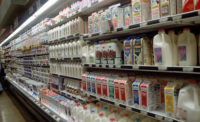Milk alternatives and plant-based products are featured twice in this issue: the Outlook Report and Market Trends. There has been much discussion about this topic thus far in 2023.
The data, presented in market trends thanks to Circana, reveals strong year-over-year gains in oat and coconut milk, as well as kefir, with some weakness in soy and almond milk.
There is a lot of opposing information out there regarding plant-based vs. dairy. It can be dizzying to try to decipher everything written. For example, a recent study by McKinsey & Co. reveals that more than one-third of consumers bought plant-based alternatives for the first time after 2020.
“In fact, the U.S. market for plant-based dairy grew by 15 percent from 2019 to 2020, by 6 percent from 2020 to 2021, and by 11 percent from 2021 to 2022,” the McKinsey report notes. “There is evidence of the continued shift toward plant-based alternatives: approximately 45% of people who consume plant-based products plan to increase such consumption in the next three years.”
However, multitudes of people are still consuming traditional milk products. “The next time you read a news article that states ‘milk is losing market share to plant-based alternatives,’ please send the reporter, the editor, anyone who will listen, a link to this column,” the National Milk Producers Federation wrote in a late July newsletter. “Because, any reputable news organization corrects fact errors, and as of this year, that statement, long accepted as the ‘inevitable’ outcome of ‘innovation,’ is no longer true. In the beverage marketplace, milk isn’t just beating plant-based on nutrition, price, overall sales and consumption volume. It’s increasing its market share too.”
Perhaps a big takeaway from the aforementioned info is that while plant-based sales are growing overall, most people are still consuming traditional dairy.
“Overall, dairy maintains a strong foothold: our survey found that almost all customers consume dairy products, with only a very small minority consuming plant-based alternatives exclusively,” McKinsey wrote in its report, adding 84% of U.S. consumers eat and drink dairy or dairy alternatives, and only 16% don’t consume either product.
“The dairy-only consumer group is primarily composed of meat eaters and tends to be older. Plant-only consumers are often younger and vegan or vegetarian,” the report stated. “And more-affluent consumers — those with a household income of $100,000 or more — tend to consume both plant-based and dairy products.”
The future of dairy versus plant-based could be a bit more murky as loyalty appears to be mixed, according to the McKinsey report.
“[Out] of consumers who have tried plant-based alternatives, 49 percent have stopped consuming dairy or consume less than they used to, whereas only about 45 percent plan to continue their usual dairy consumption,” the research firm states. “Even so, our survey found that the majority of consumers in the United States only consume dairy, not alternatives, indicating dairy’s strong market hold across the consumer landscape.”
So what can we make of all of this? It is difficult to say, but I will give it my best shot: There is a place for both traditional and plant-based dairy in the future.
Also, for dairy processors, it means following the trends. Many processors choose not to offer plant-based alternatives, but as I have been told anecdotally in conversations, dairy processors are willing to listen to the needs of their customers. Hence, if this means co-packing a dairy alternative, this is perhaps a route to additional earnings, a path some processors have already taken.




